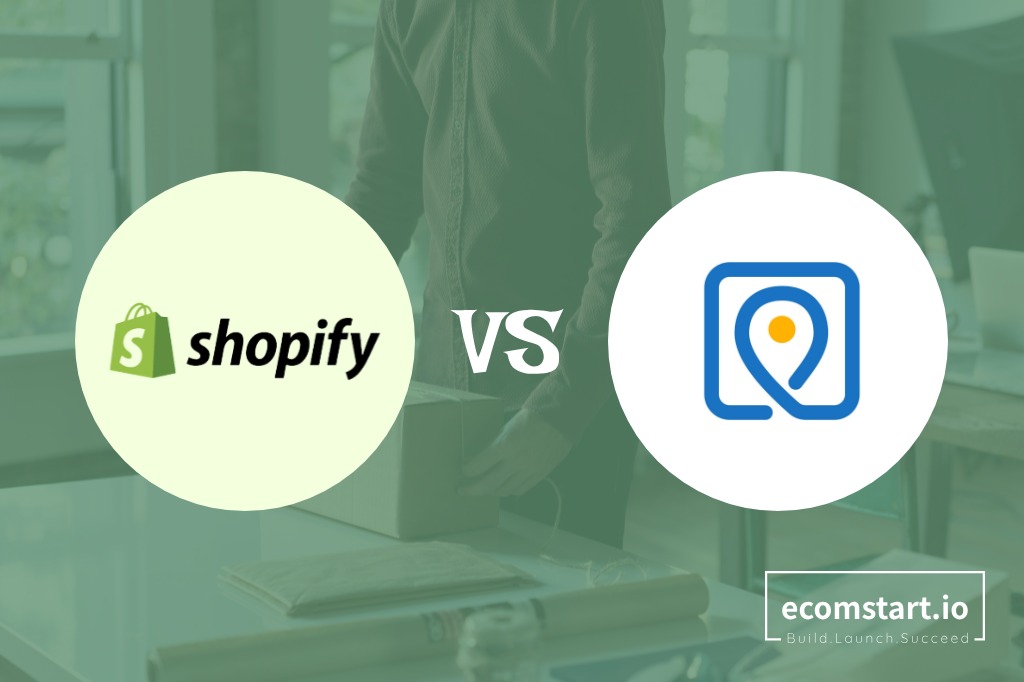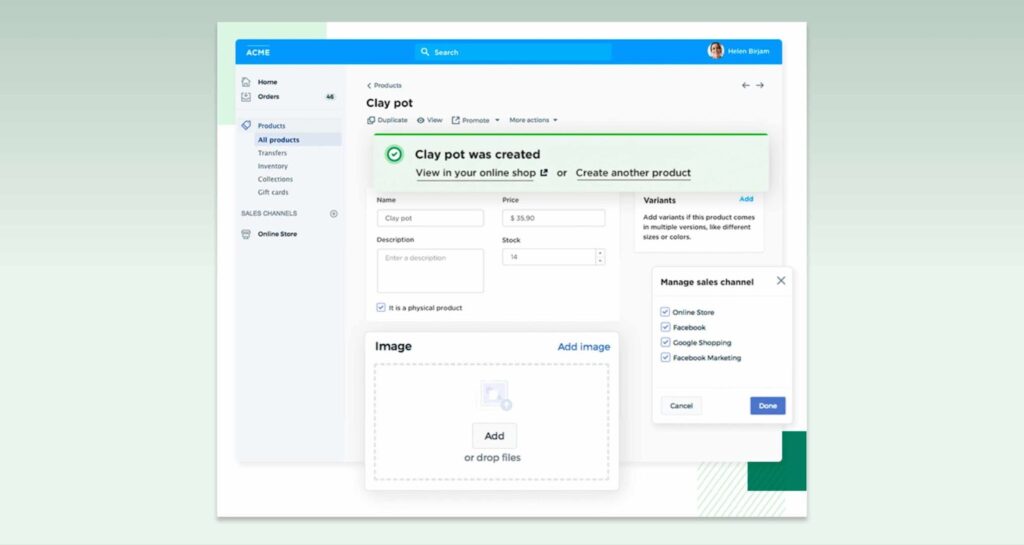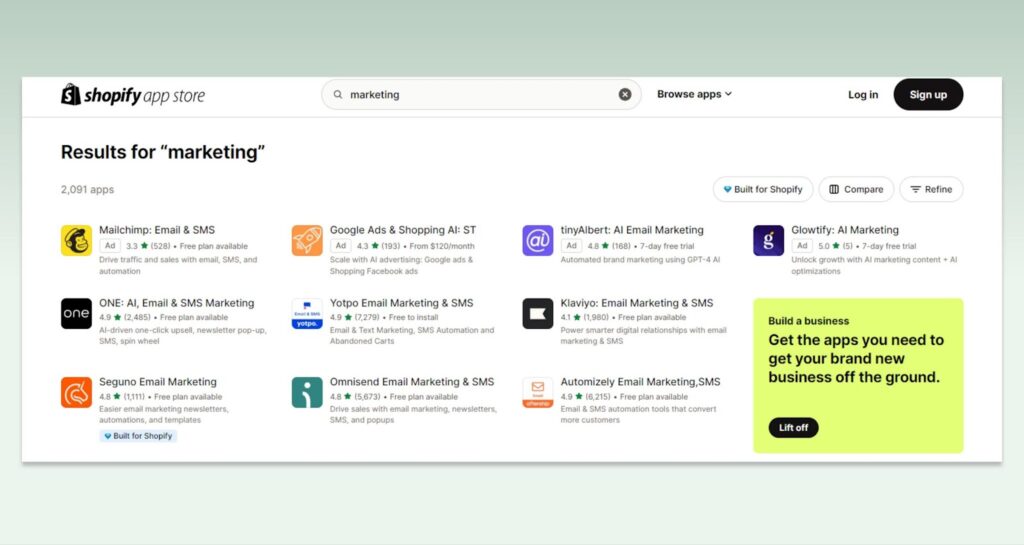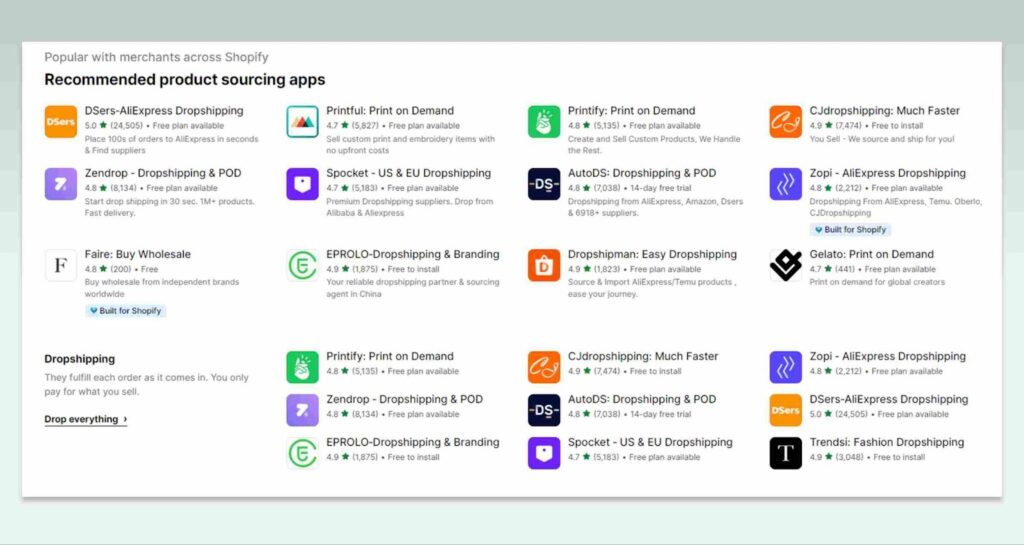Shopify vs Sellvia: Who wins the eCommerce race?

Choosing between Sellvia vs Shopify is one of the most critical decisions eCommerce entrepreneurs need to make nowadays. The comparison outlines the core differences between the two platforms, including the features, pricing, and general user experience. Throughout this article, we intend to resolve your doubts, offering straight answers to the most common difficulties in choosing an eCommerce platform.
Let’s find out which one offers the best value for your money, is easiest to use, and offers scalable options for your business. Additionally, it is essential to know the difference between Sellvia vs Shopify as the right choice might determine your online store’s prosperity. The guide is vital for anyone who wants to take an informed position in expanding the eCommerce business.
1. Shopify vs Sellvia: overview & key differences
Overview & key differences:
- Shopify is an all-in-one eCommerce platform that enables you to create and tailor an online store, inventory products, and process payments. Using its breadth of features and tools, it was established for any size business.
- Sellvia is a dropshipping wholesaler that is knowledgeable in fast US shipping. It was developed for business people who want to retail items online quickly and effortlessly without having to manage anything in reserve.
- The difference between Shopify and Sellvia stems from their primary focus and target audience. Shopify ensures convenient eCommerce tools and suitable functions for every business need. Sellvia, by contrast, focuses solely on dropshipping that accommodates various US states.
Here’s a quick comparison table to outline the differences between Shopify and Sellvia:
Shopify | Sellvia | |
|---|---|---|
Pricing | Varied plans | Subscription fee |
Design & customization | High flexibility | More streamlined |
Ease of Use | Very user-friendly | Easy integration |
eCommerce features | Wide-ranging | Dropshipping-focused |
Marketing tools | Comprehensive | Essential tools |
App & integrations | Extensive options | Focused selections |
Scalability | Great for growth | Scales with your sales |
2. Shopify vs Sellvia: a deep dive comparison
2.1. Pricing:
When considering Sellvia vs Shopify cost and fees, one must analyze the pricing structure of these two platforms to understand where one’s investment goes.
2.1.1. Shopify pricing:
In the comparison of Sellvia vs Shopify cost, Shopify offers multiple pricing plans, starting with the Basic plan at $29 a month.
This plan comes equipped with everything necessary to launch an online store from scratch, including website hosting, SSL certificate, and unlimited product stock, reflecting Shopify’s comprehensive approach to e-commerce solutions.
However, it also features extra transactional costs if one uses a payment gateway other than Shopify Payments, which costs 2.9% + 30¢ or 2.4% + 30¢ based on the subscription
Furthermore, since this platform has a variety of apps and integrations, one may need to pay extra for additional monthly functionality fees.

💡Note: Shopify is offering a good chance for new entrepreneurs to try out the excellent features with just $1. You can start the 3 days trial, then apply for the 30$ days first month for 1$ program to get everything that Shopify has to offer – in short, a very good deal that you shouldn’t miss!

2.1.2. Sellvia pricing:
Sellvia works on a subscription fee, which is priced at $39/month. This charge will provide the customer with access to their swift US shipping network and product catalog. SellVia doesn’t charge any transaction fees so the core platform is free from such payments.

But if you plan to add this to another store (for example some Shopify stores), transaction costs involved shall be considered.
2.1.3. Key takeaways:
- Monthly fees: The cheapest Shopify plan is $29/month and Sellvias is $39/month. If Sellvia’s straightforward pricing doesn’t consider additional features, entrepreneurs who aim at dropshipping solely can find this model easier to manage in this case.
- Transaction fees: As far as Shopify is concerned, the transaction fees might pile up if using other payment gateways other than Shopify Payments. Sellvia does not charge transaction fees but remember its use in conjunction with others that might.
- Additional fees: With Shopify, additional costs may come from apps and themes to enhance your store, which can significantly impact your budget. Sellvia keeps it simple with its subscription, focusing on product sourcing and fulfillment.
Verdict: When considering Shopify vs Sellvia fees, Sellvia offers better value for dropshippers looking for straightforward, predictable costs.
2.2. Design & customization:
While choosing between Shopify vs Sellvira store design and customization options, it is evident that both of them have completely different objectives.
2.2.1. Shopify design & customization:
Shopify is unique as standouts with its extremely customizable design options. It is equipped with numerous themes, both free and premium, that can easily align with any branding efforts.
Customers are enabled to effortlessly alter the layouts, colors, and fonts with a single click, this makes it possible to achieve an original online store.

There is an excellent example from Shopify, Gymshark which started as an innovative fitness apparel and accessories brand.
Through the Shopify store, their products are displayed in a clean, user-friendly format to emphasize the products and the brand value. The shop was built up with neat images and simple navigation making it easy for the customers to shop and also buy the products.
2.2.2. Sellvia design & customization:
Despite placing a strong emphasis on the quick setup of dropshipping businesses, Sellvia’s focus on speed and technical efficiency comes at the expense of versatility in design and customization when compared to Shopify.
Mainly constructed on a standardized template for rapid deployment, Sellvia stores may fall short in meeting the demands for comprehensive customization. This highlights the contrast in flexibility between dropshipping on Sellvia vs Shopify, with Shopify offering greater adaptability and personalization options.

A Cool-Clothing Store which sold about $19M also shows potential with the design and customization aspect offered by Sellvia. Such a store in Sellvia’s blog post demonstrates the capability of the platform to bring considerable revenue to a clothing store that sells both adult and kids apparel.
Verdict: The Shopify platform takes the lead for companies that emphasize specific branding and flexibility of customization in terms of the range of themes and superior design.
2.3. Ease of use:
When it comes to dropshipping on Sellvia vs Shopify, ease of use is a critical factor for anyone starting their ecommerce journey. Each of the platforms has a unique part to play but their strategies to drop shipping simplification are very different.
2.3.1. Shopify ease of use:
Shopify differentiates itself for the software’s comprehensive, easy-to-use interface. It enables individuals to easily establish their online store without the need to have a deep technical understanding.
The website provides a wide array of tutorials and the necessary support assistance to eliminate this technical barrier.
Also, the big app environment of Shopify allows business owners to add dropshipping features with apps such as Oberlo, which makes it great to use its functionality.

2.3.2. Sellvia ease of use:
Sellvia focuses specifically on dropshipping businesses. It offers a more streamlined approach to product sourcing and order fulfillment. With Sellvia, users benefit from one-click product imports to their store and automatic order fulfillment directly to their customers in the US.
This focus on efficiency and speed in setting up a dropshipping business is a significant advantage for those looking to get started quickly.

Verdict: Regarding the simplicity of use and a wide array of eCommerce functions between Sellvia vs Shopify, Shopify remains the best option to take.
2.4. eCommerce features:
In this Sellvia vs Shopify review, we’re taking a closer look at the eCommerce features each platform offers and how they stack up in real-world applications.
2.4.1. Product sourcing and inventory management
- Shopify provides a wide range of apps for product sourcing including Oberlo, which allows users to acquire products from suppliers all around the globe. Although this global network is beneficial, it may entail the lengthening of delivery times.

Shopify offers a sophisticated inventory management solution that is both thorough and seamless, ensuring that products can be assigned to various platforms without a problem.
- Sellvia separates from the crowd as it takes a more specific path. It sources its products addressing the US market exclusively; this allows faster delivery times which, undoubtedly, become a key performance indicator for dropshipping success.
The platform’s sourcing is selective, which results in less product research and quality control. Nevertheless, this could also lead to a less diverse array of items than Shopify.
2.4.2. Shipping and fulfillment:
- The quality of shipping times can change the fate of a Shopify dropshipping business. The company uses third-party apps and supplies for fulfillment purposes, often leading to the possibility of delivering orders faster or slower depending on the particular one selected and the destination chosen.
This variability requires careful management and communication with customers.
- Sellvia guarantees delivery within the US in 1-3 business days. This rapidity is of significant benefit to dropshipping stores because it improves customers’ satisfaction and stimulates repeat purchases.
Verdict: While Sellvia excels in dropshipping with its fast shipping and ease of product sourcing, Shopify takes the win for comprehensive eCommerce features.
2.5. Marketing tools:
In the Sellvia vs Shopify comparison, focusing on marketing tools can help you see which platform better supports your business’s growth through advertising, SEO, and social media presence.
2.5.1. Shopify marketing tools:
Shopify is at its strongest in marketing. It combines the power of email marketing with its dashboard, enabling you to have direct communication with the customers through it. Its SEO is quite powerful, allowing it to enrich meta titles, descriptions, and URLs to have better visibility in search engines.
With regards to social media integration, Shopify does outstandingly as it allows businesses to link their store with such platforms as Facebook and Instagram effortlessly. Furthermore, Shopify offers extensive reporting and analytics to monitor sales trends, customer behavior, and so on.
Additionally, it includes ad creation and management tools that allow you to easily make, run, and manage Google and Facebook ads from your Shopify dashboard.

Allbirds, an eCommerce company powered by Shopify, leverages all the available marketing tools of Shopify at its maximum capability.
With integrated email marketing for customer outreach, it takes advantage of Shopify’s SEO features for ranking higher on search engines, and it connects to Instagram for social media sales.
2.5.2. Sellvia marketing tools:
Sellvia works on the business aspect of eCommerce and, in particular, provides its customers with speedy delivery within the USA. Though it offers fundamental SEO practices and social media integration, its features in these areas are not so well-proposed in comparison with Shopify’s.

Sellvia utilizes email marketing methods driven by third-party services and does not provide integrated tools for ad development and management.
Its analytics is more oriented around order fulfillment and shipping times, offering just the concretions to improve operational efficiency but little depth in sales and customer behavior analysis.
EcoGear FX is a store that gains a competitive edge due to Sellvia’s fast shipping feature. Sellvia is more performance-based, while EcoGear FX relies on external means for marketing needs, such as third-party email marketing services to communicate with their customers. The basic SEO support from Sellvia makes it possible for EcoGear FX to stay visible.
Verdict: In the race to marketing tools, Shopify wins. They have provided practically every needed marketing tool including SEO to Ads management.
2.6. App & integrations:
In the difference between Shopify and Sellvia race, especially when looking at apps & integrations, it’s clear each platform has its strengths. Here’s how they stack up:
2.6.1. Shopify app & integrations:
Shopify provides you with an expansive app store that contains more than 6,000 apps, which are made to help your eCommerce store gain more features.
Whether the functionalities you are looking for are advanced SEO tools, intricate email marketing integrations, comprehensive analytics suites, or specialized shipping options among others, Shopify is more than likely to have something that suits your needs on its marketplace.

Contrasting sharply with the Sellvia store, the unparalleled flexibility and scalability of Shopify come into clear focus. This vast array of choices lets users of Shopify, as opposed to Sellvia, precisely tailor their stores to fit their business model and customer needs.
For instance, within the context of Shopify vs Sellvia store, if there’s a need for an application for customer loyalty programs, Shopify likely offers a broader range of applications, showcasing its superior adaptability.
2.6.2. Sellvia app & integrations:
Sellvia takes a more streamlined approach. It won’t have as many apps and integrations because the platform itself offers several essential features of eCommerce and mainly targets US-based dropshipping entrepreneurs.
Sellvia’s highlight is the fast shipment guarantee and it is built-in functionality that does not require any outside apps involvement.
While this gives the advantage that you will probably not have to look for other features beyond what the platform provides, the platform might turn out to be not very flexible to your special needs.
Verdict: When it comes to apps and integrations, Shopify outshines Sellvia. If you run a business that depends on having lots of tools available, then Shopify is a better option for you.
2.7. Scalability:
In the Shopify vs Sellvia store battle, especially when we talk about scalability, it’s crucial to see how each platform supports business growth.
2.7.1. Shopify scalability:
Shopify shines as a very robust platform for eCommerce businesses of all sizes. It provides different plans from Shopify Basic for entrepreneurs starting to Shopify Plus for large businesses.
This scalability ensures that as your business grows, Shopify can handle more products, more intricate modifications, and greater traffic volume without affecting the performance of your website.
Furthermore, Shopify’s large ecosystem of apps and integrations makes it possible to easily adopt new features as your business’s needs change. Whether you want to increase the line of your product, venture into new markets, or even grow your marketing efforts, Shopify is capable of it.
2.7.2. Sellvia scalability:
Sellvia boosts operational speed and ease in starting an eCommerce business, mostly focused on the U.S. market. Sellvia still needs to address scalability issues. The eCommerce solution is built for speedy operations and is meant for companies that want to begin selling online without much complication.

However, as your business grows, you might find Sellvia’s feature set a bit restrictive, especially if you’re looking to diversify your sales channels or go global. Sellvia is made to be easy but does not have the same extent of complexity and opportunities for expansion as Shopify does.
Verdict: Shopify is the preferred option for businesses that anticipate rapid growth. It gives you more chances to grow your brand.
3. Shopify vs Sellvia: who holds the winning hand?
In the Shopify vs Sellvia debate on who holds the winning hand, your choice boils down to what you’re looking for in an eCommerce platform. Both have their pros and cons, especially when it comes to costs and fees.
3.1. Choose Shopify if:
- You need a platform that will expand along with your enterprise. Shopify offers different plans to adapt to the needs of businesses ranging from small to large scale. This implies you may begin small and improve as you expand.
- You want some flexibility in the apps and integrations too. With Shopify add-ons, you can do almost anything and customize your store in so many ways.
- You’re okay with paying a monthly fee plus a small percentage of your sales. While Shopify charges subscription fees and transaction fees monthly, these costs are obvious and transparent.
- You are planning to expand your business internationally. Shopify catering to a variety of languages and currencies helps sell out the globe.
3.2. Choose Sellvia if:
- You are targeting the US market. Sellvia offers fast domestic delivery which makes them the right choice for customers from the US.
- You prefer an all-in-one solution with fewer external apps needed. With Sellivia’s simple and user-friendly interface, management becomes a breeze.
- You intend to lower initial costs. Even though Sellvia and Shopify subscriptions are charged monthly, Sellvia’s pricing is considered simpler, especially for new businesses.
- For you, speedy delivery is the major selling point. Sellvia’s quick fulfillment times within the US can be a major advantage for your store.
When considering Shopify vs Sellvia fees, Shopify tends to offer more flexibility and options at the cost of potentially higher fees depending on the plan and integrations you choose.
✨ Learn more: Pietra Vs Shopify: Which One Is Best To Use In 2024?
4. Conclusion
In the battle between Sellvia vs Shopify, selecting the fruitful platform is dictated by your business aims and objectives. If you are specifically heading to grow huge while expanding globally, Shopify gives you all the needed platforms and flexibility.
In contrast, Sellvia is a smart option when it comes to starting up fast and quickly taking over the US market with fast shipping. Both of these solutions are strong depending on what you need them for. The best picks are based on your special requirements.
For a deeper understanding and ways will make your store successful, go to Ecomstart at ecomstart.io. Here we take the difficult eCommerce topics and turn them into easy-to-follow advice. You can easily decide on Sellvia or Shopify, our major duty is to support you to succeed in the eCommerce world.
If you like Shopify but still wonder whether this is the right platform to choose, read our Shopify vs other platforms comparison guide to find out.


